“The Ultimate Highest Fiber Food Chart [Free Printable]” was written by Mitzi de Maa, RD, LDN. Edited/reviewed by Katie Dodd, MS, RDN, CSG, LD, FAND.
As dietitians, we are often asked about fiber, it’s importance to our health, and what foods can help us increase our intake. With this article, we answer those very questions. Let’s begin!
Have you been wondering which foods are highest in fiber? In this article you will learn all about the health benefits of fiber, what a day of high fiber meals looks like, and we’ll share some helpful tips on how to get more fiber into your diet.
Did you know populations that consume more dietary fiber have less chronic disease? (1) This shows us some of the great benefits of a high fiber diet. Let’s learn more about how beneficial fiber is and what the highest fiber foods are.
Plus, we are including a free PDF of our highest fiber food chart so you can print it and share it with loved ones!
<< Download and print your FREE Highest Fiber Food Chart (made by a dietitian!) >>
<< Jump to article section on Highest Fiber Foods Chart >>
Table of Contents:
- Highest Fiber Food Chart: What is Fiber?
- Benefits of a High Fiber Diet
- Recommendations for Daily Fiber Intake
- A Day of Meals from the Highest Fiber Food Chart
- Which Foods are Highest in Fiber?
- Highest Fiber Food Chart (separated by food groups)
- Highest Fiber Food Chart [Free Download]
- Practical Tips to Eat More Fiber
- What About Fiber Supplements?
- Highest Fiber Food Chart Conclusion
Highest Fiber Food Chart: What is Fiber?
Fiber is a carbohydrate found in plants that cannot be digested by the human body.
This means that it passes through the body without being digested (basically unchanged). However, this does not mean that it does not provide us with many health benefits – which we will learn about in this article.
Fiber is divided into two categories, soluble and insoluble. (2) Many high fiber foods contain both types of fiber.
Soluble Fiber
Soluble fiber dissolves in water during digestion and forms a gel that helps to slow down digestion. It also helps make you feel fuller for a longer period of time.
Benefits of Soluble Fiber:
- Slows down digestion
- Lowers blood cholesterol and blood sugar levels
- Feeds our good gut bacteria which can lower inflammation in the body (2)
Examples of Soluble Fiber:
- Carrots
- Broccoli
- Onion
- Artichoke
- Bananas
- Berries
- Apples
- Pears
- Legumes
- Oats
- Barley
Insoluble Fiber
Insoluble fiber does not dissolve in water, but rather, absorb water. As a result, insoluble fiber helps to form bulkier stools which can then help prevent constipation.
Benefits of Insoluble Fiber:
- Helps move food through your digestive system (and in turn helps you go to the bathroom with more regularity)
- Prevents and treats constipation
Examples of Insoluble Fiber:
- Whole grains
- Wheat
- Bran
- Nuts
- Seeds
- Cauliflower
- Green beans
- Potatoes
- Carrots
- Berries
Check out our Insoluble Fiber Foods Chart for more information!
Benefits of a High Fiber Diet
There are many benefits of a high fiber diet, including:
- Reduced risk of cardiovascular diseases by reducing blood cholesterol
- Treatment and prevention constipation, hemorrhoids, and diverticulosis
- Increased satiety which can help with weight management
- Feeding our good gut bacteria which can lower inflammation in the body
- Slows down the body’s absorption of glucose (sugar) which is helpful for conditions like diabetes
Recommendations for Daily Fiber Intake
| Age 18-50 | Age 50+ | |
| Men | 38 grams per day | 30 grams per day |
| Women | 25 grams per day | 21 grams per day |
Fiber Fact:
Did you know that most Americans consume an average of 15 grams of fiber every day? This is less than half of the recommended amount for men ages 18-50, and 10 grams under the recommended amount for women ages 18-50.
A Day of Meals From the Highest Fiber Food Chart
Below you will find an example of what a full day of high fiber meals looks like. Let’s dig in!
- Breakfast: high fiber cereal
- Morning snack: popcorn with apple slices
- Lunch: veggie lentil soup
- Afternoon snack: hummus with carrots
- Dinner: chicken fajita tacos with guac and pico
High Fiber Breakfast: High Fiber Cereal
Did you know that you can make your cereal bowl high in fiber, even if the cereal alone is not high in fiber?
You can get 18 grams of fiber from ⅔ cup of Fiber One cereal and 4 grams of fiber from ½ cup of raspberries. Make sure to add your milk of choice and enjoy your breakfast!
Learn more at our article: The Ultimate List of Cereals that are High in Fiber. Want even more high fiber breakfast inspiration? Be sure to check out High Fiber Breakfast Ideas.
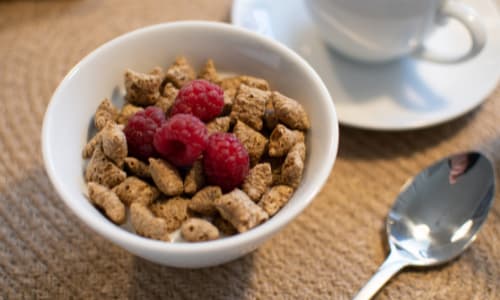
High Fiber Snack: Popcorn with Apple Slices
You can get 4 grams of fiber from 3 cups of air-popped popcorn and 5.4 grams of fiber from 1 large apple with the skin on. Try slicing your apple and adding some peanut butter if you need a protein boost.
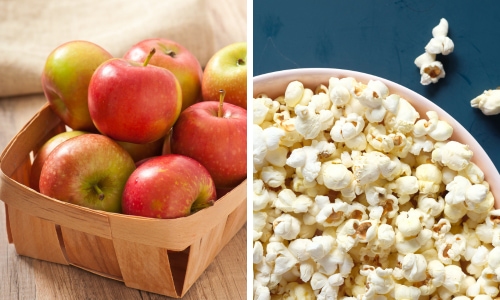
High Fiber Lunch: Vegetable Lentil Soup
A homemade or store-bought vegetable lentil soup is a delicious and satisfying lunch that can help you meet your fiber goals.
This soup can provide 8 grams of fiber from ½ cup of cooked lentils, and approximately another 4 grams of fiber from the vegetables in the soup (such as cooked carrots and green beans).
Other high fiber lunch ideas include: black bean and chicken quesadillas, or an egg and avocado wrap.
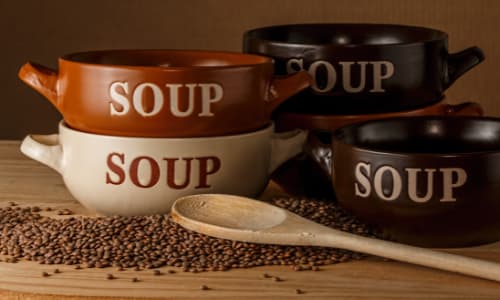
High Fiber Snack: Hummus with Carrots
This delicious snack provides 1.8 grams of fiber from 2 tablespoons of hummus and 3.6 grams of fiber from 1 cup of raw carrots. Almost 5.5 grams of fiber from this easy on-the-go snack? Count us in!
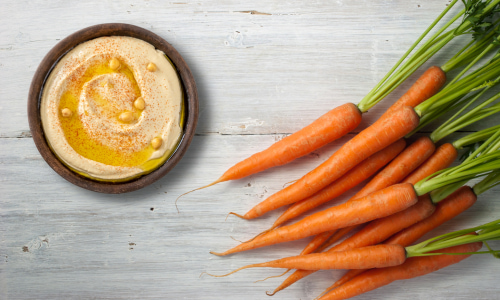
High Fiber Dinner: Chicken Fajita Tacos with Guacamole and Pico De Gallo
Two whole wheat tortillas have approximately 8 grams of fiber. While, ⅓ of a medium avocado provides 3 grams of fiber, and 1 cup of Pico de Gallo has approximately 1 gram of fiber. This Taco Tuesday meal offers around 12 grams of fiber.
Additional high fiber dinners include: chicken quinoa bowls with veggies and salsa, or spaghetti with beans or lentils mixed in.
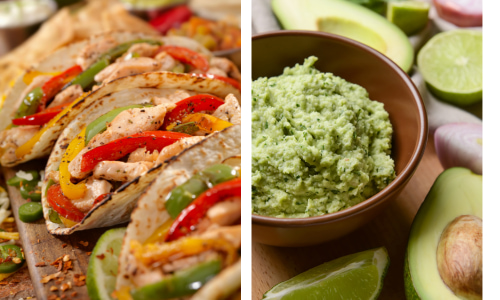
Important Highest Fiber Food Chart Recommendations
It is important to start introducing high fiber foods into your diet slowly. If you eat too much fiber too quickly, you can experience bloating, gas, constipation, or distention. Be sure to take it slow and steady.
Water and fiber are good friends! Water helps fiber pass smoothly through our digestive tract so make sure to drink enough fluids when eating high fiber foods.
Which Foods are Highest in Fiber?
To recognize how much fiber we are getting from a certain food, we can look at the nutrition facts label in the back of the food product to learn more.
As an example, let’s take the nutrition facts label of chia seeds which is a food high in fiber and packed with nutrients:
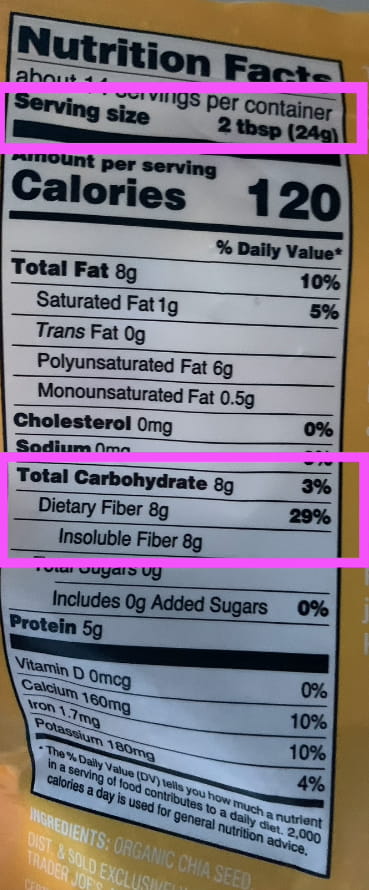
According to the nutrition label above, we see that 2 tablespoons (24 grams) of chia seeds provides 8 grams of dietary fiber (as shown in the pink boxes).
This is an excellent amount of fiber considering the daily recommendations described above. If you are interested in learning more about how much fiber each food product has, you can always look at the nutrition facts label.
Remember to pay attention to the serving size to know exactly how much fiber a serving size contains.
Highest Fiber Food Chart (separated by food groups)
The tables below are referenced from the 2020-2025 Dietary Guidelines for Americans.
Highest Fiber Fruits
| FRUITS | Serving Size | Fiber (grams per serving) |
| Guava | 1 cup | 8.9 |
| Blackberries | 1 cup | 8 |
| Raspberries | 1 cup | 8 |
| Pear | 1 medium pear | 5.5 |
| Avocado | ½ cup | 5 |
| Blueberries | 1 cup | 6.2 |
| Apple with skin | 1 large | 5.4 |
| Figs, dried | ¼ cup | 3.7 |
| Goji berries, dried | 5 Tbsp | 3.6 |
| Banana | 1 large | 3.5 |
| Prunes, dried | ¼ cup | 3.1 |
| Orange | 1 fruit | 3.1 |
| Strawberries | 1 cup, sliced | 3 |
| Mango | 1 cup | 2.6 |
| Raisins | 1/4 cup | 1.8 |
Highest Fiber Vegetables
| VEGETABLES | Serving Size | Fiber (grams per serving) |
| Artichoke, cooked | 1 cup | 9.6 |
| Green peas, cooked | 1 cup | 8.8 |
| Pumpkin, canned | 1 cup | 7.1 |
| Brussel sprouts, cooked | 1 cup | 6.4 |
| Sweet potato, cooked | 1 cup | 6.3 |
| Collards, fresh, cooked | 1 cup | 5.6 |
| Broccoli, cooked | 1 cup | 5.2 |
| Turnip greens, fresh, cooked | 1 cup | 5.1 |
| Cauliflower, cooked | 1 cup | 4.9 |
| Spinach, cooked | 1 cup | 4.3 |
| Beets, raw | 1 cup | 3.8 |
| Carrots, raw | 1 cup | 3.6 |
| Corn, canned | 1 cup | 3.3 |
| Eggplant, raw | 1 cup | 2.4 |
| Celery, raw | 1 cup | 2 |
Highest Fiber Beans
| BEANS | Serving Size | Fiber (grams per serving) |
| Navy beans, cooked | ½ cup | 9.6 |
| Small white beans, cooked | ½ cup | 9.3 |
| Yellow beans, cooked | ½ cup | 9.2 |
| Lima beans, cooked | 1 cup | 9.2 |
| Peas, split, cooked | ½ cup | 8.1 |
| Lentils, cooked | ½ cup | 7.8 |
| Pinto beans, cooked | ½ cup | 7.7 |
| Chickpeas (garbanzo beans), cooked | ½ cup | 6.3 |
| Kidney beans, canned | ½ cup | 5.5 |
Highest Fiber Cereals
| CEREALS | Serving Size | Fiber (grams per serving) |
| Fiber One, General Mills | ½ cup | 13 |
| Bran Buds, Kellogg’s | ⅓ cup | 12 |
| All-Bran, Kellogg’s | ½ cup | 10 |
| Raisin Bran, Kellogg’s | ¾ cup | 8.2 |
| Instant Oatmeal | 1 pack | 3 |
| Cheerios | 1 cup | 3 |
Highest Fiber Grains
| GRAINS | Serving Size | Fiber (grams per serving) |
| Farrow, dry | 1/2 cup | 5.5 |
| Whole wheat tortilla | 1 medium | 4.4 |
| Oats | 1/2 cup | 4 |
| Quinoa, cooked | 1/2 cup | 2.4 |
| Bulgur, cooked | ¼ cup | 2.1 |
| Whole wheat crackers | 8 crackers | 2 |
| Popcorn | 1 cup | 1.9 |
| Rye bread | 1 medium slice | 1.9 |
| Barley, pearled, cooked | ¼ cup | 1.5 |
Highest Fiber Seeds and Nuts
| SEEDS AND NUTS | Serving Size | Fiber (grams per serving) |
| Chia seeds | 2.5 Tbsp | 9 |
| Flax seeds | 1.5 Tbsp | 3.6 |
| Pistachios | 1 oz | 2.8 |
| Pumpkin seeds, whole | 1 oz | 5.2 |
| Coconut | 1 oz | 4.6 |
| Almonds | 1 oz | 3.6 |
| Sunflower seeds | 1 oz | 3.2 |
| Pecans | 1 oz | 1.6 |
| Walnuts | 1 oz | 1.5 |
Highest Fiber Food Chart [Free Download]
As promised, here is your Highest Fiber Food Chart! If you’d like, you can print it and put it in your fridge, take it grocery shopping, and even share it with your loved ones!
CLICK HERE (or on the image below) to download your free copy.
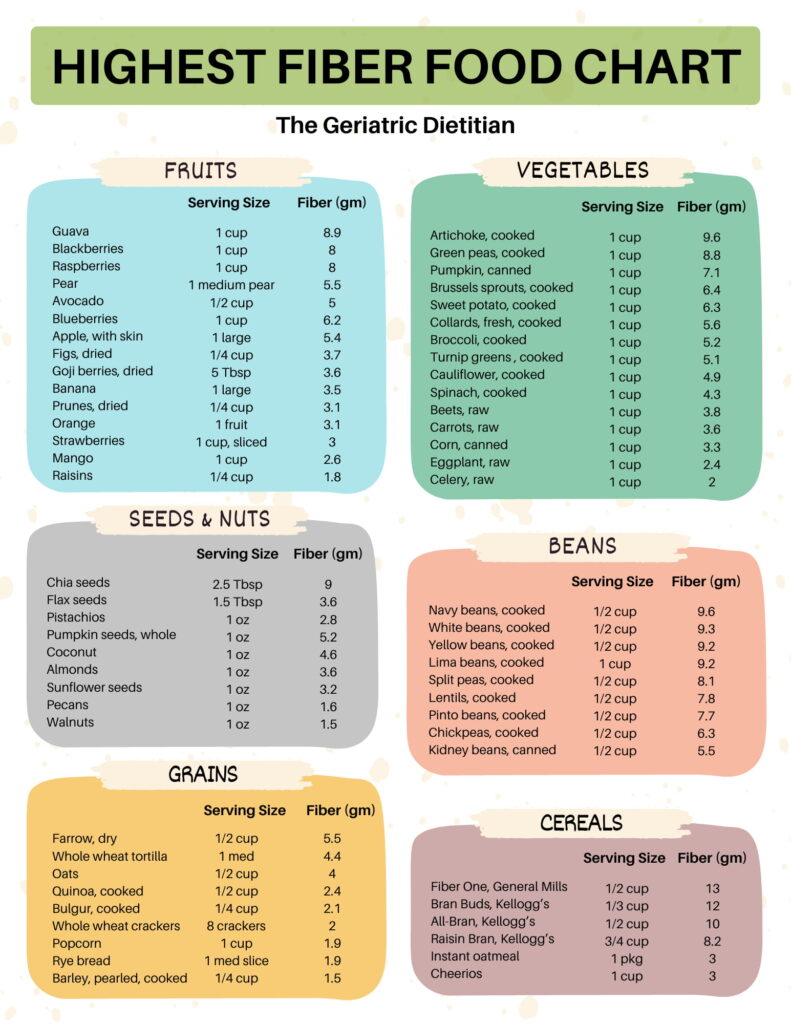
If you’re interested in learning more about low fiber foods, check out our Low Fiber Food List [Free Download].
Practical Tips To Eat More Fiber with the Highest Fiber Food Chart
Now that you know the highest fiber foods, you may think, “But where do I start? Is there a certain meal or snack that is easiest to add fiber to?”
Don’t worry, we’re sharing some practical tips that you might find helpful to start adding more fiber-rich foods to your daily diet.
- Add chia seeds to your yogurt, toast, salads, or smoothies.
Chia seeds are a powerhouse. In just 2 tablespoons you can get 8 grams of fiber! They have a mild flavor and can be added to foods such as yogurt, toast, salads, or smoothies.
- Add beans to soups, chilis, or salads
As you learned above, beans are fiber-packed and can be paired with many different foods. An easy way to add more beans in your diet is by adding canned beans to soups, chilis, or salads.
You can store cans in the pantry and use them at your convenience. This can help save you time, money, and effort. If you have the space, stock up every once in a while when you’re at the grocery store.
It’s easier to add beans to your diet if you always have some around!
- Snack on fruits and nuts
Feeling hungry in between meals? Don’t hesitate to grab a snack to reenergize your body. A great way to add more high fiber foods into your day is by snacking with high fiber options.
For example, you can make a plate with apple slices with the skin, whole-grain crackers, and hummus. Or, try making some homemade trail mix with your favorite dried fruits, nuts, and popcorn.
- Make delicious smoothies
Smoothies are one of the easiest ways to pack nutrients into one drink. To make your smoothie more fiber-licious, add vegetables, berries (such as frozen raspberries or blueberries), chia seeds, and flax seeds.
What About Fiber Supplements?
Here at The Geriatric Dietitian, we like to recommend that nutrients come from foods first. Whole food sources provide so many additional nutrients and health benefits that it’s worth prioritizing them over a supplement.
Food sources of fiber might not be the best choice for everyone. Please be sure to consult with your doctor, healthcare team, and/or a registered dietitian before adding any kind of supplement to your diet.
Highest Fiber Food Chart Conclusion
Remember, although it may feel like you are making small changes, every little step forward is positively impacting your health and adds up in the long run. Every step counts!
We hope that after reading this article you feel inspired and empowered to start eating more fiber-rich foods every day.
Don’t forget to download your FREE Highest Fiber Food Chart! And, check out the links below for more resources to support you on your high fiber diet journey:
